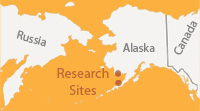 |
 |
 |
 |
 |
 |
 |
 |
The Plan
Figuring out how to observe walrus at land haulouts was a challenge for the research team.
Their system needed to be:
- Low cost
- Low maintenance (because sites are in remote locations)
- Able to measure duration (from the first walrus to arrive to the last walrus to leave)
- Able to visually observe the presence of walrus and allow for a census count
- Able to observe the cause(s) of possible disturbances
- Minimally disruptive to the animals
While brainstorming, many methods were considered. The team thought about using airplanes to fly over haulout sites. They considered asking locals to report observations or stationing their own research staff near haulouts throughout the entire summer season. Finally, the team talked about placing remote video or still cameras at known haulout locations.
The pros and cons for each method were evaluated. Flying over sites would be expensive and time consuming because the range of Pacific walruses covers thousands of miles. The sound of low flying planes might also disturb the animals. Local observations are impossible in many areas because haulouts are so remote. And stationing field researchers at known haulouts all season could prove very expensive.
In the end, the team concluded that setting up remote cameras was the most cost-effective choice. They also decided that using still cameras set on timers would let them get the most data about how walrus were using land haulouts.
Watch the two videos below to learn about the equipment Dr. Polasek's team used and some of the challenges they had to deal with while designing a plan to observe walrus using remote cameras.
VIDEO: Equipment
But won’t it get wet? Terril Efird talks about the equipment the team chose and how they keep it dry and functioning in the maritime climate. (1 minute)
VIDEO: Challenges
Terril Efird describes some of the challenges involved in monitoring walrus. (35 seconds)
With these challenges in mind, the scientists put a lot of thought into selecting the best locations to set up their cameras. Continue on to the "Action!" page to see which sites along Alaska's coastline they chose.
 |







